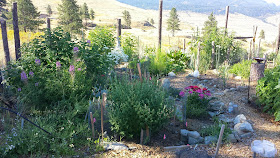You may not realize it, but old sheets can make the difference between wildlife getting everything, and having food left over for humans to eat from the garden. I have lettuce growing all throughout this garden. In all places where it is out in the open, it is eaten down to nubs, mainly by marmots. However, within the circle of sheets, there are some beautiful lettuce plants especially for our family to eat. They were intended to be "round two" of successional planting, so they're not quite ready to sustain our salad habits, but they will be soon.
Big thanks to everyone who shared old sheets with me. Cheers -- it's working!
The sheets surround the majority of the Alderwood Patch. The fabric creates a visual and perhaps an olfactory barrier, so far making it much harder for the marmots to discover these plants. This is the first year that we have grown peas without them being eaten down -- not even once! It's not that the marmots couldn't get into the sheet house, it's just that they don't see what's inside, so it doesn't occur to them. (Let's hope this continues...)
My daughter and I build this cucumber tipi together. At first it was intended to simply be a trellis for the plants; then I draped an opaque curtain over one side as a wind break.
When our cucumbers plants became a marmot target, I realized that I was "most of the way there" in protecting the cucumbers. I added one wall of plastic sheeting on the south side and used clothespins to keep everything in place. So far so good!
Now, if I were a marmot, I would want to investigate this further! It was our daughter's idea to camouflage the Havahart trap, then Lee suggested it as well, along with the strategy of a trail of goodies leading to the opening. Thank you Lee, for lending us your larger trap!
I didn't want to disrupt the trap's function but I layered on vegetation wherever I thought it would be out of the way. Notice the carrots growing in the foreground on the right, half-eaten by the marmots. They love carrot tops!
This was Marmot #3 caught this year, named "Chirpess" by our daughter.
Here M is releasing "Chirpess" at a location where another young marmot greeted us upon arrival. She is sure this other marmot was "Chirper," Marmot #1 caught and released earlier this year.
This is "Chirpess" after leaving the trap. Looks like a good release location!
I believe that in every situation in life, there is something to be learned.
Okay, so what can you learn from marmots in the garden?
Well, there is a good reason the marmots eat so many of the carrot tops. The greens taste great and are good for you! Carrots are part of the umbelliferae family (celery, parsnip, fennel, cumin, cilantro, and parsley, etc.). They do have alkaloids -- along with lots of other greens -- so I'm not going to over do it, but throwing some into my salads adds chlorophyll, potassium, and lots of other great minerals and vitamins. Everything in moderation, and it's always good to rotate your greens. I hear some people are allergic or intolerant of carrot greens, but I really enjoy homegrown carrot tops, knowing they haven't been sprayed with any pesticides. I'll follow the marmots' lead and harvest some before they do!
I first heard about eating carrot greens from local organic farmer and Netherlander, Ton Rietveld of Leaping Sheep Farms. I was thrilled to discover this additional crop (thanks, Ton!). As 'Garden Betty' says: "Just because these things are not culturally popular does not mean they’re not nutritious or can’t be eaten; in fact, the leaves of root vegetables tend to be more healthful than the roots themselves." So as you are thinning those crazy twisted carrots from your garden, don't forget to bring some carrot greens to the table, too!

Most of my lettuce may be eaten down by marmots at the moment, but it will grow back. In the meantime, they won't stop me from enjoying salads! I made the above salad this morning from carrot greens, chopped snap peas, baby carrots (harvested during thinning), sprouts from a jar in the kitchen, and organic pinto beans from Azure Standard. A little olive oil and balsamic vinegar, and I'm in salad heaven! I may be frustrated that so much lettuce has been eaten down, but the marmots are causing me to be more creative in making salads -- and it's good to eat a diverse diet, right?
Do you like to eat carrot greens?
If so, what's your favorite way to prepare them?
Please leave your comments below.
























